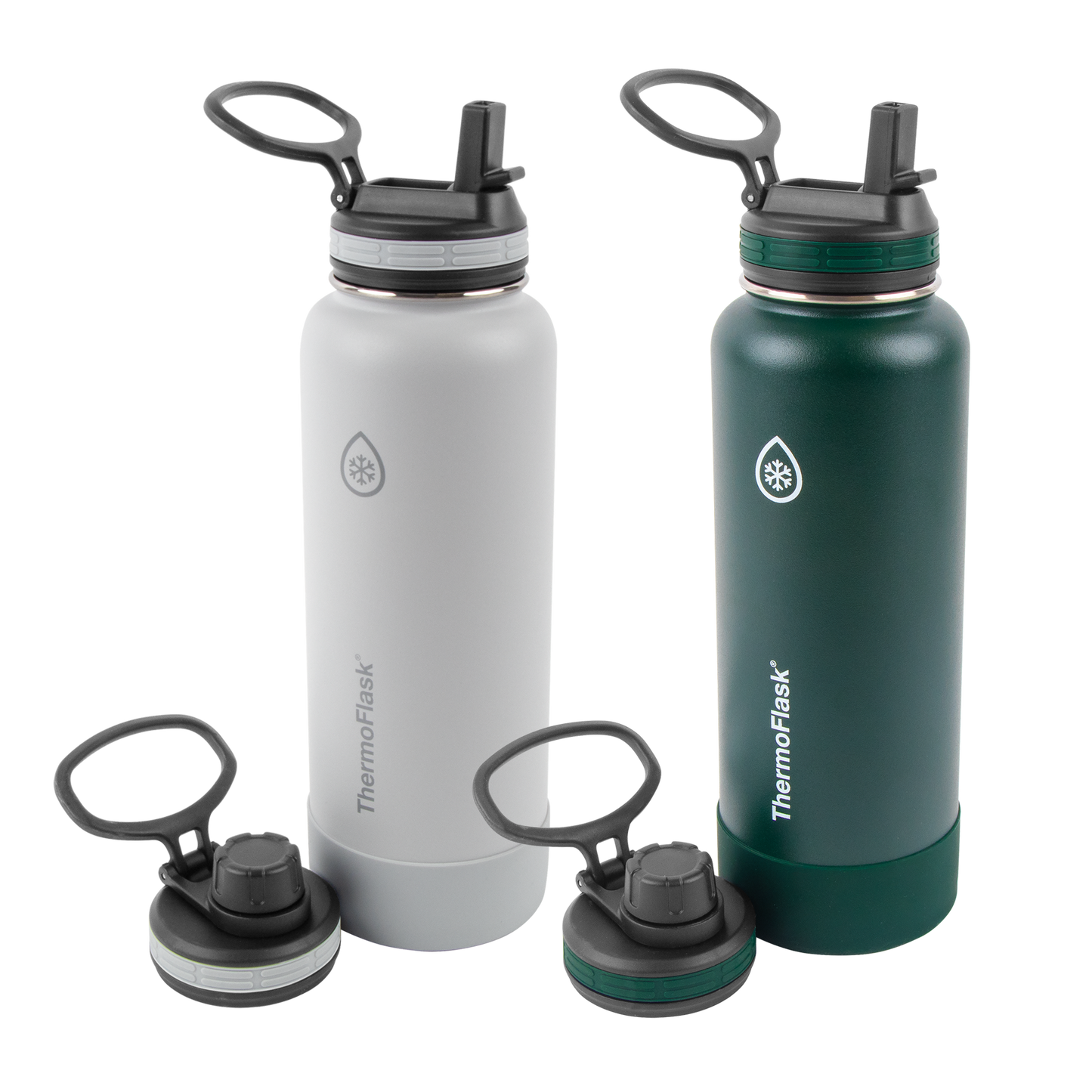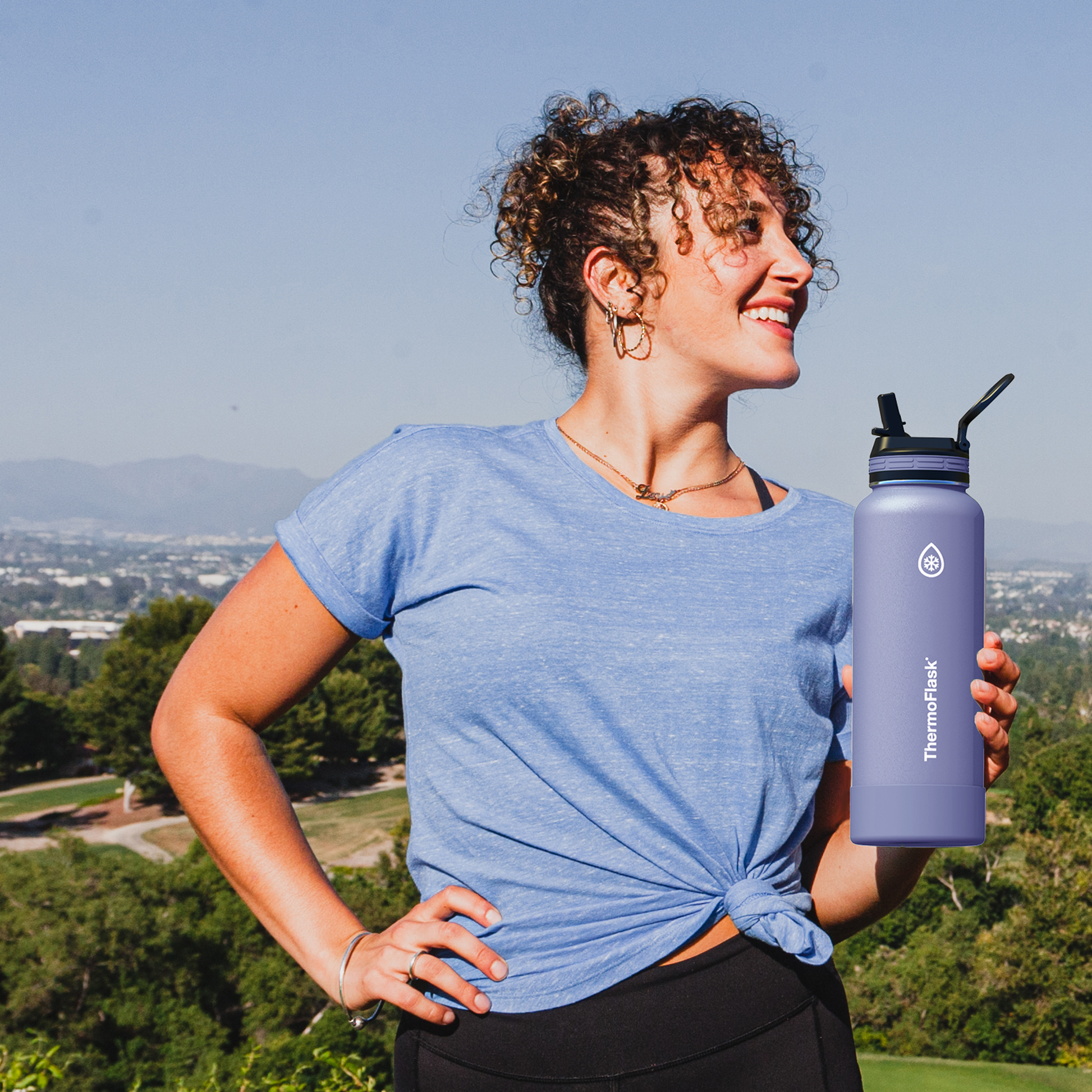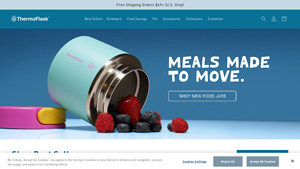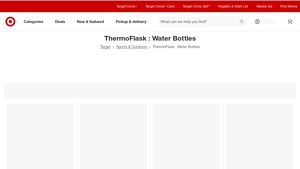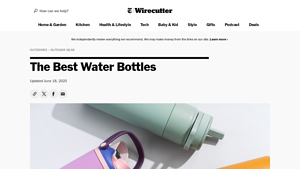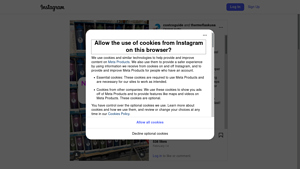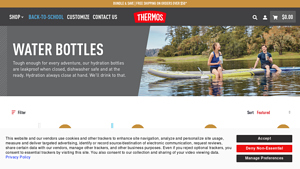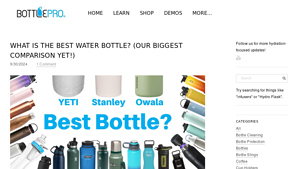Introduction: Navigating the Global Market for thermo flask water bottles
In today’s dynamic global market, sourcing thermo flask water bottles presents a unique challenge for B2B buyers, especially those operating in regions such as Africa, South America, the Middle East, and Europe, including countries like Germany and Saudi Arabia. With an increasing demand for sustainable, insulated drinkware that meets both consumer preferences and environmental standards, navigating this landscape requires a keen understanding of product specifications, supplier capabilities, and market trends.
This comprehensive guide delves into the diverse types of thermo flask water bottles available, their various applications across industries, and essential considerations for supplier vetting. We will also explore cost structures, highlighting value propositions that align with your business goals. By equipping international buyers with actionable insights and practical strategies, this resource empowers you to make informed purchasing decisions, ensuring that your product offerings meet market demands while also optimizing your supply chain efficiency.
Whether you are looking to enhance your product line with innovative designs or seeking reliable suppliers who prioritize quality and sustainability, this guide serves as your roadmap to successfully navigate the complexities of the thermo flask water bottle market.
Artikel navigatie
- Top 7 Thermo Flask Water Bottles Manufacturers & Suppliers List
- Introduction: Navigating the Global Market for thermo flask water bottles
- Understanding thermo flask water bottles Types and Variations
- Key Industrial Applications of thermo flask water bottles
- 3 Common User Pain Points for ‘thermo flask water bottles’ & Their Solutions
- Strategic Material Selection Guide for thermo flask water bottles
- In-depth Look: Manufacturing Processes and Quality Assurance for thermo flask water bottles
- Practical Sourcing Guide: A Step-by-Step Checklist for ‘thermo flask water bottles’
- Comprehensive Cost and Pricing Analysis for thermo flask water bottles Sourcing
- Alternatives Analysis: Comparing thermo flask water bottles With Other Solutions
- Essential Technical Properties and Trade Terminology for thermo flask water bottles
- Navigating Market Dynamics and Sourcing Trends in the thermo flask water bottles Sector
- Frequently Asked Questions (FAQs) for B2B Buyers of thermo flask water bottles
- Belangrijke disclaimer en gebruiksvoorwaarden
- Strategic Sourcing Conclusion and Outlook for thermo flask water bottles
Understanding thermo flask water bottles Types and Variations
| Type Naam | Belangrijkste onderscheidende kenmerken | Primaire B2B-toepassingen | Korte voor- en nadelen voor kopers |
|---|---|---|---|
| Geïsoleerde waterflessen | Double-wall vacuum insulation, keeps beverages hot or cold for hours | Relatiegeschenken, outdoor evenementen, sportscholen | Voordelen: Excellent thermal retention, durable. Minpunten: Heavier than non-insulated options. |
| Reistassen | Designed for hot beverages, often with spill-proof lids | Coffee shops, travel agencies, corporate events | Voordelen: Convenient for on-the-go, stylish designs. Minpunten: Beperkte capaciteit vergeleken met flessen. |
| Kids’ Thermo Bottles | Smaller size, vibrant colors, often with safety lids | Scholen, kinderdagverblijven, familie-evenementen | Voordelen: Lightweight, appealing to children. Minpunten: May not suit adult needs. |
| Voedsel Potten | Designed for solid foods, often with wide mouths for easy access | Catering services, meal prep companies | Voordelen: Versatile for meals, reusable. Minpunten: Bulkier for liquid-only use. |
| Specialty Lids | Various lid types (straw, chug, sip-n-lok) for different uses | Restaurants, cafes, promotional products | Voordelen: Customizable for specific needs. Minpunten: Requires inventory management for multiple options. |
What are the Key Characteristics of Insulated Water Bottles?
Insulated water bottles are designed with double-wall vacuum insulation, allowing them to maintain the temperature of beverages for extended periods. These bottles are particularly suitable for B2B applications such as corporate gifts or outdoor events, where maintaining beverage temperature is crucial. When purchasing, businesses should consider the material durability, capacity options, and whether the bottles are dishwasher safe, as these factors impact both usability and longevity.
How Do Travel Tumblers Serve the B2B Market?
Travel tumblers are ideal for hot beverages and often come with features like spill-proof lids and ergonomic designs. They are commonly used in coffee shops, travel agencies, and corporate events, making them a popular choice for promotional items. B2B buyers should evaluate the branding potential, thermal efficiency, and ease of cleaning when selecting tumblers, as these aspects can enhance customer satisfaction and brand visibility.
Why Are Kids’ Thermo Bottles Important for Businesses?
Kids’ thermo bottles are tailored for younger users, featuring vibrant colors and safety lids to prevent spills. These bottles find applications in schools, daycare centers, and family-oriented events. When sourcing these products, businesses should prioritize lightweight materials and design safety features, as these elements will appeal to parents and educational institutions looking for reliable hydration solutions for children.
What Makes Food Jars a Versatile Choice for B2B Buyers?
Food jars are designed for storing solid foods and often come with wide mouths for easy access. Their primary applications include catering services and meal prep companies. When considering food jars, B2B buyers should look at the versatility of use, ease of cleaning, and whether they can accommodate various food types. This makes them an excellent choice for businesses focusing on sustainability and reusable products.
How Do Specialty Lids Enhance the Functionality of Thermo Flask Products?
Specialty lids, including straw, chug, and sip-n-lok options, allow for customization based on specific user needs. They are particularly relevant for restaurants, cafes, and promotional products where customer experience is key. Buyers should assess the compatibility of these lids with existing product lines and consider the implications for inventory management, as offering multiple lid types can enhance customer satisfaction but also complicate stock control.
Key Industrial Applications of thermo flask water bottles
| Industrie/sector | Specific Application of thermo flask water bottles | Waarde/Voordeel voor het bedrijf | Belangrijkste overwegingen bij de inkoop voor deze toepassing |
|---|---|---|---|
| Eten en drinken | Catering and event services using insulated drinkware | Enhanced customer satisfaction with temperature control | Durability, capacity, and customization options |
| Outdoor & Recreation | Hydration solutions for outdoor adventures and sports events | Increased brand visibility and customer loyalty | Lightweight materials and ease of transport |
| Gezondheidszorg | Employee hydration programs in hospitals and clinics | Promotes wellness and reduces plastic waste | Sterilization capabilities and BPA-free materials |
| Onderwijs | Providing students with reusable water bottles in schools | Supports sustainability initiatives and reduces costs | Bulk purchasing options and branding opportunities |
| Relatiegeschenken | Customized thermo flasks as promotional items for businesses | Strengthens brand identity and client relationships | Customization options and minimum order quantities |
How Are Thermo Flask Water Bottles Used in the Food & Beverage Industry?
In the food and beverage sector, thermo flask water bottles are essential for catering and event services. They maintain the temperature of beverages, ensuring that hot drinks stay warm and cold drinks remain refreshing throughout events. This not only enhances customer satisfaction but also reduces the need for single-use plastic containers, aligning with sustainability goals. Buyers should consider durability, capacity, and the potential for customization to meet branding needs when sourcing these products.
What Role Do Thermo Flask Water Bottles Play in Outdoor & Recreation?
For businesses in the outdoor and recreation industry, insulated water bottles serve as vital hydration solutions for activities such as hiking, camping, and sports events. By offering products that keep liquids at optimal temperatures, companies can boost brand visibility and foster customer loyalty. Buyers should prioritize lightweight materials and portability, ensuring that the bottles are easy to carry during outdoor adventures.
Why Are Thermo Flask Water Bottles Important in Healthcare?
In healthcare settings, thermo flask water bottles are increasingly used in employee hydration programs within hospitals and clinics. They provide a sustainable alternative to disposable bottles, promoting wellness among staff while also contributing to environmental efforts. When sourcing for this application, it’s crucial to ensure that the bottles are made from sterilizable materials and are BPA-free, addressing health and safety concerns.
How Do Thermo Flask Water Bottles Benefit Educational Institutions?
Educational institutions are adopting thermo flask water bottles as part of their sustainability initiatives. Providing students with reusable bottles not only reduces waste but also encourages healthy hydration habits. For B2B buyers in this sector, bulk purchasing options and the ability to customize bottles with school logos are key considerations that can enhance the overall appeal of the product.
What Are the Advantages of Using Thermo Flask Water Bottles as Corporate Gifts?
Customized thermo flask water bottles serve as effective promotional items for businesses looking to strengthen their brand identity. They can be given as corporate gifts to clients and employees, fostering relationships while promoting a commitment to sustainability. When sourcing these products, businesses should focus on customization options and minimum order quantities to ensure they meet their marketing goals efficiently.
3 Common User Pain Points for ‘thermo flask water bottles’ & Their Solutions
Scenario 1: Ensuring Product Durability for Varied Climates
Het probleem: B2B buyers often face challenges in sourcing thermo flask water bottles that can withstand diverse climatic conditions. In regions like Africa and South America, extreme heat can cause inferior products to break down quickly, leading to customer dissatisfaction and increased return rates. Buyers may also struggle with inconsistent quality, as products manufactured in different countries may not hold up under similar environmental stressors. This inconsistency can damage brand reputation and lead to financial losses.
De oplossing: To ensure product durability, B2B buyers should prioritize sourcing thermo flasks from reputable manufacturers who provide detailed specifications on materials and testing processes. Look for bottles made from high-quality stainless steel with double-wall vacuum insulation. Request samples to evaluate their performance in extreme temperatures before making bulk purchases. Additionally, consider suppliers who offer warranties or guarantees on their products, which can serve as a safety net if the bottles fail to meet performance expectations. Regularly engage with suppliers for updates on production practices and quality control measures to ensure ongoing reliability.
Scenario 2: Addressing Customization and Branding Needs
Het probleem: Many B2B buyers want to offer customized thermo flask water bottles to enhance their brand visibility but encounter limitations with suppliers regarding customization options. Buyers may struggle to find manufacturers that allow for unique designs, colors, or branding elements, which can hinder their ability to differentiate their products in competitive markets. This lack of personalization can lead to missed opportunities for branding and customer loyalty.
De oplossing: To effectively address customization needs, buyers should research and partner with suppliers that specialize in bespoke thermo flask solutions. Request detailed catalogs showcasing available customization options, including color choices, printing techniques, and material variations. Engage in discussions about minimum order quantities and the potential for prototypes before committing to larger orders. By establishing a clear communication channel with suppliers, buyers can also explore collaborative design opportunities, ensuring that the final product aligns with their branding strategy. Utilizing digital mock-ups during the design phase can also help visualize the end product before production.
Scenario 3: Overcoming Logistics and Supply Chain Challenges
Het probleem: B2B buyers often face logistical challenges when importing thermo flask water bottles, especially when dealing with international suppliers. Issues such as shipping delays, customs regulations, and fluctuating import costs can disrupt inventory management and lead to stockouts. Buyers may also struggle to find reliable shipping partners who can handle fragile items without damage during transit.
De oplossing: To mitigate logistics challenges, B2B buyers should develop a robust supply chain strategy that includes multiple reliable shipping partners. Engage with logistics providers who have experience in handling delicate goods and can offer insights into the best practices for shipping thermo flasks. Negotiate terms with suppliers that allow for flexible shipping schedules to accommodate demand fluctuations. Additionally, utilize technology such as inventory management software to track stock levels and predict when to reorder, which can help prevent stockouts. Building strong relationships with both suppliers and logistics partners can facilitate smoother communication and expedite issue resolution, ensuring a more seamless supply chain.
Strategic Material Selection Guide for thermo flask water bottles
What Are the Key Materials Used in Thermo Flask Water Bottles?
When selecting materials for thermo flask water bottles, several common options stand out due to their unique properties, advantages, and limitations. Understanding these materials from a B2B perspective is crucial for international buyers, especially those operating in diverse markets such as Africa, South America, the Middle East, and Europe.
How Does Stainless Steel Perform as a Material for Thermo Flask Water Bottles?
Stainless steel is one of the most popular materials for thermo flask water bottles due to its excellent temperature retention, durability, and resistance to corrosion. It typically has a temperature rating that can withstand high heat, making it suitable for both hot and cold beverages. The key advantages of stainless steel include its long lifespan and ability to resist rust, which is particularly valuable in humid or corrosive environments.
However, stainless steel can be more expensive than other materials, which may impact cost-sensitive buyers. Manufacturing complexity is moderate; while stainless steel is readily available, the processes for shaping and finishing can add to production costs. For international buyers, compliance with standards such as ASTM and ISO is essential, especially in markets with stringent regulations like Germany and Saudi Arabia.
What Role Does BPA-Free Plastic Play in Thermo Flask Water Bottles?
BPA-free plastic is often used in thermo flask water bottles, particularly for lightweight and cost-effective options. This material is known for its impact resistance and versatility, making it suitable for various designs and applications. It is also resistant to corrosion and can be produced in a variety of colors and styles.
The primary advantage of BPA-free plastic is its lower cost compared to metals, making it an attractive option for budget-conscious buyers. However, it may not retain temperatures as effectively as stainless steel and can be less durable over time, especially under high-temperature conditions. International buyers should consider local regulations regarding plastic usage and safety standards, as preferences for sustainable materials are increasing globally.
Why Is Glass a Viable Option for Thermo Flask Water Bottles?
Glass is another material that is gaining traction in the thermo flask market due to its aesthetic appeal and non-reactive properties. It is excellent for maintaining the purity of beverages without imparting flavors or chemicals. Glass bottles can also provide superior insulation when combined with vacuum-sealed designs.
Despite its advantages, glass is heavier and more fragile than other materials, which can limit its practicality for on-the-go use. The manufacturing process can also be more complex and costly, affecting the overall price point. International buyers need to be aware of shipping and handling considerations, especially in regions where breakage during transport could be a concern.
How Does Aluminum Compare as a Material for Thermo Flask Water Bottles?
Aluminum is lightweight and offers good thermal conductivity, making it a popular choice for thermo flask water bottles. It is often coated with a protective layer to prevent corrosion and enhance durability. Aluminum bottles can be produced in various colors and designs, appealing to a wide range of consumers.
The key advantage of aluminum is its lightweight nature, which makes it ideal for outdoor and travel applications. However, it can dent easily and may not provide the same level of insulation as stainless steel. For B2B buyers, understanding the coatings used and ensuring compliance with international standards is crucial, especially in markets with strict regulations on materials.
Summary Table of Material Properties
| Materiaal | Typical Use Case for thermo flask water bottles | Belangrijkste voordeel | Belangrijkste nadeel/beperking | Relatieve kosten (laag/gemiddeld/hoog) |
|---|---|---|---|---|
| Roestvrij staal | High-end insulated bottles for hot/cold drinks | Excellent durability and corrosion resistance | Higher cost and moderate manufacturing complexity | Hoog |
| BPA-vrij plastic | Lightweight, budget-friendly options | Cost-effective and versatile | Less effective temperature retention and durability | Laag |
| Glas | Premium bottles for pure beverage experiences | Non-reactive and aesthetic appeal | Zwaar en breekbaar | Medium |
| Aluminium | Lightweight, outdoor-focused applications | Lichtgewicht en goede thermische geleidbaarheid | Prone to dents and less insulation | Medium |
This strategic material selection guide provides valuable insights for B2B buyers looking to source thermo flask water bottles. By understanding the properties and implications of each material, businesses can make informed decisions that align with their operational needs and market demands.
In-depth Look: Manufacturing Processes and Quality Assurance for thermo flask water bottles
What Are the Key Manufacturing Processes for Thermo Flask Water Bottles?
The manufacturing of thermo flask water bottles involves several critical stages that ensure both functionality and durability. Understanding these stages can help B2B buyers evaluate potential suppliers more effectively.
1. Material Preparation: What Materials Are Used?
The primary materials for thermo flasks are stainless steel and high-grade plastics. Stainless steel, often 18/8 grade (also known as 304), is favored for its resistance to corrosion and ability to maintain temperature. High-quality plastics, like BPA-free Tritan or Polypropylene, are used for lids and other components.
Before manufacturing, these materials undergo a rigorous selection process. Suppliers must provide certifications for material quality, ensuring they meet international standards. Buyers should verify that suppliers can trace their material sources, especially when dealing with suppliers in regions with varying quality control standards.
2. How Are Thermo Flask Bottles Formed?
The forming stage typically involves processes such as stamping, deep drawing, and injection molding. For stainless steel flasks, sheets are stamped into the desired shape, followed by deep drawing to form the body of the bottle. This process must be meticulously controlled to ensure uniform wall thickness, which is critical for thermal insulation.
For plastic components, injection molding is commonly used. This technique allows for precise shaping and is essential for creating components like lids and spouts. Quality at this stage is paramount, as any defects can lead to product failures.
3. What Is the Assembly Process for Thermo Flasks?
Once the components are formed, they are assembled. This may involve welding, screw fastening, or snap-fitting, depending on the design. The assembly process must be performed in a clean environment to prevent contamination, especially since these products are intended for food and beverage use.
Automated assembly lines are often employed to enhance efficiency and consistency. However, human oversight remains essential to ensure that each unit meets quality standards. B2B buyers should inquire about the assembly methods used by suppliers to understand their production capabilities.
4. How Are Thermo Flask Bottles Finished?
Finishing processes include polishing, coating, and printing. Polishing is crucial for stainless steel products to enhance appearance and remove any surface imperfections. Coatings may be applied for aesthetic purposes or to improve grip and usability.
Additionally, printing techniques are employed for branding and labeling. It’s important that these finishes are durable and resistant to wear, particularly for products intended for outdoor use. Buyers should assess the finishing techniques and materials used by suppliers to ensure they align with their branding and quality expectations.
What Quality Assurance Practices Are Essential for Thermo Flask Manufacturing?
Quality assurance (QA) is integral to the manufacturing process, ensuring that every product meets industry standards and customer expectations.
1. Which International Standards Should B2B Buyers Consider?
B2B buyers should look for suppliers that adhere to international quality standards such as ISO 9001, which outlines requirements for a quality management system. Compliance with other certifications, such as CE marking for products sold in Europe and API standards for specific applications, can also indicate a commitment to quality.
Understanding the relevant certifications for your target markets, such as those in Africa, South America, the Middle East, and Europe, is critical. These regions may have unique regulatory requirements that suppliers must meet.
2. What Are the Key Quality Control Checkpoints?
Quality control (QC) checkpoints are essential throughout the manufacturing process. Common checkpoints include:
- Inkomende kwaliteitscontrole (IQC): This stage involves inspecting raw materials upon arrival to ensure they meet specified standards.
- Kwaliteitscontrole tijdens het proces (IPQC): During manufacturing, random inspections are conducted to identify defects early in the production line.
- Final Quality Control (FQC): This involves a comprehensive inspection of finished products to ensure they meet all specifications before shipping.
Implementing these checkpoints helps mitigate risks associated with defective products reaching the market.
3. How Can B2B Buyers Verify Supplier Quality Control?
B2B buyers can verify a supplier’s QC processes through several methods:
- Audits: Conducting regular audits of suppliers can provide insights into their manufacturing and quality practices. This could include reviewing their production facilities and quality control processes.
- Kwaliteitsrapporten: Requesting detailed quality reports can help buyers understand how suppliers monitor and manage quality.
- Inspecties door derden: Engaging third-party inspection services can provide an unbiased assessment of a supplier’s QC processes. This is particularly important for buyers in regions with less stringent regulations.
4. What Are the Nuances of QC for International Buyers?
B2B buyers, especially those from diverse regions, must consider the nuances of quality control practices. For instance, suppliers in Europe may have different compliance requirements compared to those in Africa or South America. Understanding local regulations, consumer expectations, and supplier capabilities is crucial.
Buyers should also be aware of cultural differences in business practices and communication. Establishing strong relationships with suppliers and maintaining open lines of communication can help ensure that quality standards are consistently met.
Conclusion: Ensuring Quality in Thermo Flask Water Bottles
The manufacturing processes and quality assurance practices for thermo flask water bottles are intricate and require careful consideration. B2B buyers should prioritize suppliers who demonstrate a commitment to quality through established processes, certifications, and transparency. By understanding these aspects, buyers can make informed decisions that align with their quality expectations and market requirements.
Practical Sourcing Guide: A Step-by-Step Checklist for ‘thermo flask water bottles’
Inleiding
This sourcing guide is designed to assist B2B buyers in navigating the procurement process for thermo flask water bottles. Whether you are looking to supply your retail business, corporate gifting, or promotional materials, this checklist will help streamline your decision-making process and ensure you select the best products and suppliers for your needs.
Stap 1: Je technische specificaties definiëren
Establishing clear technical specifications is critical to ensure the thermo flask water bottles meet your requirements. Consider factors such as capacity (e.g., 16oz, 25oz), materials (e.g., stainless steel, BPA-free plastics), and insulation type.
– Key features to define:
– Type of lid (screw, spout, or straw)
– Temperature retention capabilities
– Customization options (colors, branding)
Stap 2: Onderzoek potentiële leveranciers
Conduct thorough research to identify reputable suppliers who specialize in thermo flask water bottles. Utilize online directories, industry trade shows, and referrals from industry contacts to compile a list of potential vendors.
– What to look for:
– Supplier experience and market presence
– Product range and availability
– Customer reviews and testimonials
Stap 3: Leverancierscertificeringen evalueren
Verifying supplier certifications is essential to ensure compliance with international standards and regulations. Look for certifications such as ISO 9001 for quality management systems and FDA approval for food safety.
– Why it matters:
– Ensures product safety and quality
– Builds trust in supplier reliability
– May be a requirement for your market or industry
Stap 4: Monsters aanvragen voor kwaliteitsbeoordeling
Before finalizing your order, request samples from shortlisted suppliers. Assess the quality, durability, and overall design of the thermo flask water bottles.
– What to evaluate:
– Insulation effectiveness during temperature tests
– Material quality and finish
– Ease of use and cleaning
Stap 5: Compare Pricing and Payment Terms
Gather quotes from multiple suppliers to compare pricing and payment terms. While cost is a significant factor, consider the overall value, including shipping costs, bulk discounts, and payment flexibility.
– Tips for negotiation:
– Discuss payment terms (e.g., deposits, credit terms)
– Inquire about discounts for larger orders
– Understand lead times and delivery schedules
Stap 6: Assess After-Sales Support and Warranty
Evaluate the after-sales support offered by suppliers, including warranty terms and return policies. Reliable after-sales service can significantly impact your satisfaction and ongoing relationship with the supplier.
– Key considerations:
– Length and coverage of warranty
– Responsiveness to queries and issues
– Availability of replacement parts or services
Stap 7: Finalize Your Order and Confirm Logistics
Once you have selected a supplier, finalize your order details, including quantity, design specifications, and delivery timeline. Confirm logistics arrangements to ensure timely delivery, especially if you are operating within tight schedules.
– Logistics considerations:
– Shipping methods and costs
– Customs and import duties (for international orders)
– Tracking options for shipments
By following this step-by-step checklist, B2B buyers can make informed decisions when sourcing thermo flask water bottles, ensuring a successful procurement process that meets their specific needs.
Comprehensive Cost and Pricing Analysis for thermo flask water bottles Sourcing
What Are the Key Cost Components in Sourcing Thermo Flask Water Bottles?
When sourcing thermo flask water bottles, understanding the cost structure is essential for B2B buyers. The primary cost components include:
-
Materialen: The quality of materials such as stainless steel, BPA-free plastics, and silicone can significantly affect costs. High-grade materials that offer durability and insulation properties tend to be more expensive.
-
Arbeid: Labor costs vary by region. In countries with lower labor costs, manufacturers can offer competitive pricing. However, labor quality and expertise in production can also influence the final product’s quality.
-
Productie Overhead: This includes expenses related to facility maintenance, utilities, and administrative costs. Efficient production processes can help minimize these overheads.
-
Gereedschap: Custom designs or unique features may require specific tooling, which can add to the initial investment. Buyers should consider whether the tooling costs will be amortized over a larger order volume.
-
Kwaliteitscontrole (QC): Implementing strict quality control measures ensures product reliability, but it also adds to the overall cost. Buyers should assess the level of QC required based on their market needs.
-
Logistiek: Transportation and shipping costs can vary widely depending on the destination and shipping terms. Buyers must account for potential tariffs or import duties when calculating total logistics costs.
-
Marge: Supplier margins typically range from 10% to 30%, depending on the supplier’s market position and negotiation power.
How Do Price Influencers Affect Thermo Flask Water Bottles?
Several factors can influence pricing in the thermo flask market:
-
Volume/MOQ: Minimum order quantities (MOQs) can greatly impact unit costs. Larger orders usually lead to lower prices per unit due to economies of scale.
-
Specificaties en aanpassingen: Custom designs, colors, and features can increase costs. Suppliers may charge a premium for bespoke products, so it’s vital to understand your needs before negotiating.
-
Material Choices: The choice of material can significantly influence price. High-quality, eco-friendly materials may come with a higher cost but can appeal to consumers looking for sustainable options.
-
Quality Certifications: Certifications such as ISO or FDA compliance can increase costs but may be necessary for market entry, especially in regulated industries.
-
Factoren van leveranciers: The supplier’s reputation, reliability, and production capacity can affect pricing. Established suppliers may command higher prices due to perceived quality and service reliability.
-
Incoterms: Understanding Incoterms (International Commercial Terms) is crucial for international buyers. They define responsibilities for shipping, insurance, and duties, which can impact overall costs.
What Tips Can Help Buyers Negotiate Better Prices for Thermo Flask Water Bottles?
To maximize cost-efficiency, consider these strategies:
-
Conduct Thorough Market Research: Understand prevailing market prices and trends. This knowledge will empower you during negotiations.
-
Volumekortingen benutten: Whenever possible, consolidate orders to meet or exceed MOQs, as this can lead to significant savings.
-
Focus op totale eigendomskosten (TCO): Consider not just the purchase price but also the long-term costs associated with the product, including maintenance, replacement, and potential waste.
-
Negotiate Payment Terms: Explore favorable payment terms that can improve cash flow. Extended payment periods can ease financial pressure.
-
Establish Long-Term Relationships: Building strong relationships with suppliers can lead to better pricing, preferential treatment, and enhanced service.
-
Be Aware of Pricing Nuances for International Buyers: Different regions may have varying price expectations and negotiation styles. Understanding local customs and practices can enhance your negotiation effectiveness.
What Should Buyers Keep in Mind About Pricing?
While prices can vary based on numerous factors, it is essential to approach pricing discussions with a clear understanding of both your needs and the supplier’s capabilities. Always seek indicative prices but recognize that final quotes may fluctuate based on specific requirements and market conditions.
Alternatives Analysis: Comparing thermo flask water bottles With Other Solutions
Understanding Alternatives to Thermo Flask Water Bottles
In the pursuit of effective hydration solutions, many businesses consider various options. Thermo flask water bottles have gained popularity due to their insulation capabilities, but it’s essential to evaluate alternatives that may also meet specific needs. This analysis compares thermo flask water bottles with two viable alternatives: traditional plastic water bottles and stainless steel water bottles.
Vergelijkende tabel
| Vergelijkingsaspect | Thermo Flask Water Bottles | Traditional Plastic Water Bottles | Stainless Steel Water Bottles |
|---|---|---|---|
| Prestaties | Excellent insulation; keeps liquids hot or cold for extended periods | Limited insulation; primarily for short-term use | Good insulation; keeps liquids cold or hot, but less effective than thermo flasks |
| Kosten | Moderate ($20 – $40) | Low ($1 – $5) | Moderate to High ($15 – $50) |
| Gemak van implementatie | Ready to use; minimal setup | Very easy; just fill and use | Ready to use; minimal setup |
| Onderhoud | Easy to clean; dishwasher safe | Single-use or recyclable; less maintenance required | Requires occasional cleaning; can be prone to dents |
| Beste gebruikscasus | Ideal for outdoor activities, travel, and long-duration events | Suitable for casual, short-term hydration | Good for daily use and eco-friendly options |
Gedetailleerd overzicht van alternatieven
Traditional Plastic Water Bottles
Plastic water bottles are widely available and inexpensive, making them an attractive option for budget-conscious businesses. They are lightweight and disposable, which can be convenient for single-use scenarios. However, they lack insulation properties, meaning they do not keep beverages at desired temperatures for long. Additionally, environmental concerns regarding plastic waste may deter businesses from choosing this option for sustainable practices.
Stainless Steel Water Bottles
Stainless steel water bottles offer a balance between functionality and durability. They typically provide better insulation than plastic bottles and are more resilient to wear and tear. Their sleek design appeals to many consumers, and they are often reusable, promoting sustainability. However, the initial cost is higher compared to plastic options, and they may require more maintenance to keep them in optimal condition, especially if they are not dishwasher-safe.
Conclusion: Choosing the Right Hydration Solution
When selecting a hydration solution, B2B buyers should assess their specific requirements, including budget, intended use, and environmental considerations. Thermo flask water bottles excel in performance and insulation, making them ideal for businesses needing reliable hydration during extended outdoor activities. However, if cost is a primary concern or if short-term use is anticipated, traditional plastic water bottles might suffice. For those prioritizing sustainability and durability, stainless steel bottles present a compelling alternative. Ultimately, the decision should align with the organization’s values and operational needs, ensuring that the chosen solution effectively meets hydration demands.
Essential Technical Properties and Trade Terminology for thermo flask water bottles
What Are the Key Technical Properties of Thermo Flask Water Bottles?
When evaluating thermo flask water bottles for B2B procurement, understanding their technical specifications is critical. Here are some essential properties to consider:
-
Materiaalklasse
Thermo flasks are typically made from stainless steel, plastic, or glass. Stainless steel, particularly 18/8 grade, is highly preferred due to its durability, resistance to rust, and ability to retain temperature. For B2B buyers, selecting the right material impacts the product’s longevity and performance, ensuring customer satisfaction. -
Type isolatie
The effectiveness of insulation, often achieved through double-wall vacuum technology, is a key specification. This design minimizes heat transfer, keeping liquids hot or cold for extended periods. Understanding insulation types helps businesses gauge product performance, which can be a differentiating factor in competitive markets. -
Capacity/Tolerance
Common capacities for thermo flasks range from 16oz to 64oz. Tolerance refers to the allowable variation in these measurements, which is crucial for manufacturers to ensure consistency. Accurate capacity and tolerance specifications help businesses manage inventory effectively and meet customer needs without overproducing. -
Lid and Spout Design
Different lid types, such as chug lids, straw lids, or sip lids, cater to various consumer preferences. The design impacts usability and convenience, crucial factors for B2B buyers targeting specific market segments. Understanding these options enables businesses to align product offerings with consumer demands. -
Gewicht en draagbaarheid
The weight of a thermo flask influences its portability, especially for consumers who value on-the-go convenience. Lighter materials can enhance user experience, making them more appealing for outdoor or travel-related markets. B2B buyers should consider these factors to optimize their product selections. -
Durability and Impact Resistance
Thermo flasks should withstand daily wear and tear, especially in active environments. Durability ratings can indicate how well a product will perform under stress, which is essential for B2B buyers focused on quality assurance and customer satisfaction.
What Are Common Trade Terms in the Thermo Flask Industry?
Understanding industry-specific terminology is vital for effective communication in B2B transactions. Here are some common trade terms:
-
OEM (Original Equipment Manufacturer)
OEM refers to a company that produces parts or equipment that may be marketed by another manufacturer. For thermo flask buyers, partnering with OEMs can allow for customization and branding opportunities, enhancing product differentiation in the market. -
MOQ (minimale bestelhoeveelheid)
MOQ is the smallest quantity a supplier is willing to sell. This term is crucial for B2B buyers to understand as it affects inventory costs and purchasing strategies. Knowing the MOQ helps businesses manage cash flow and stock levels effectively. -
RFQ (Offerteaanvraag)
An RFQ is a document issued by a buyer to solicit price quotes from suppliers. For thermo flask procurement, an RFQ outlines specific product requirements, helping buyers compare offers and negotiate terms. -
Incoterms (internationale handelsvoorwaarden)
Incoterms are a set of predefined commercial terms published by the International Chamber of Commerce (ICC). They clarify the responsibilities of buyers and sellers in international transactions, influencing shipping costs and logistics management for thermo flask imports and exports. -
Doorlooptijd
Lead time refers to the time taken from placing an order to delivery. Understanding lead times is essential for B2B buyers to manage inventory levels and meet customer demand. It can also influence supplier selection, impacting overall supply chain efficiency. -
Certification Standards
These are industry-specific benchmarks that products must meet to ensure safety and quality. For thermo flasks, certifications like FDA approval or BPA-free labeling are important for compliance and marketability. Familiarity with certification standards helps B2B buyers ensure their products meet regulatory requirements.
By grasping these technical properties and trade terms, B2B buyers can make informed decisions that align with their business goals and customer expectations.
Navigating Market Dynamics and Sourcing Trends in the thermo flask water bottles Sector
What Are the Key Market Dynamics and Trends Influencing the Thermo Flask Water Bottles Sector?
The global market for thermo flask water bottles is being significantly influenced by a combination of health consciousness, environmental awareness, and lifestyle changes. As consumers increasingly prioritize hydration and sustainability, there is a growing demand for high-quality, insulated drinkware that maintains beverage temperatures for extended periods. This trend is particularly pronounced among international B2B buyers in Africa, South America, the Middle East, and Europe, who seek products that align with both functional and eco-friendly values.
Emerging technology is reshaping sourcing trends in this sector. For instance, advancements in materials science have led to the development of lighter, more durable, and eco-friendly materials, such as stainless steel and BPA-free plastics. Additionally, innovations in manufacturing processes, including automated production lines, are enhancing efficiency and reducing costs. B2B buyers are also leveraging digital platforms for sourcing, allowing for more streamlined procurement processes and access to a broader range of suppliers.
Another critical market dynamic is the rise of personalization and customization options, driven by consumer preferences for unique and branded products. This trend provides B2B buyers with opportunities to differentiate their offerings and cater to specific market segments, especially in competitive regions like Europe and the Middle East, where brand loyalty is paramount.
How Can Sustainability and Ethical Sourcing Impact Your B2B Strategy in the Thermo Flask Water Bottles Market?
Sustainability is no longer just a buzzword; it has become a crucial factor in the purchasing decisions of both consumers and businesses. The environmental impact of single-use plastic bottles has prompted significant shifts towards reusable thermo flask water bottles. B2B buyers must consider suppliers who prioritize sustainable practices, from sourcing raw materials to manufacturing processes. This not only enhances brand reputation but also aligns with the growing regulatory pressures for environmentally responsible business operations.
Ethical sourcing practices are equally important. Buyers should ensure that their suppliers maintain transparency in their supply chains, adhere to fair labor practices, and minimize environmental footprints. Certifications such as Fair Trade, ISO 14001 for environmental management, and materials like recycled stainless steel and BPA-free plastics can serve as indicators of a supplier’s commitment to sustainability.
By prioritizing sustainability and ethical sourcing, B2B buyers can better meet the demands of eco-conscious consumers while securing a competitive edge in the market. This approach fosters brand loyalty and positions companies as responsible players in the thermo flask water bottle sector.
What is the Brief History and Evolution of Thermo Flask Water Bottles?
The evolution of thermo flask water bottles can be traced back to the early 20th century, when scientists first developed vacuum insulation technology. Initially used for laboratory equipment, this innovation soon found its way into consumer products. The first commercial vacuum flasks were introduced in the 1900s, designed for transporting hot and cold liquids.
Over the decades, the design and materials used in thermo flasks have evolved significantly. The introduction of lightweight materials, such as stainless steel and high-grade plastics, has made these products more accessible and practical for everyday use. In recent years, the focus has shifted towards sustainability, leading to the development of eco-friendly designs that cater to the modern consumer’s needs. As a result, thermo flask water bottles have transitioned from niche products to mainstream essentials, reflecting broader lifestyle trends and consumer preferences for health and environmental consciousness.
Frequently Asked Questions (FAQs) for B2B Buyers of thermo flask water bottles
-
How do I choose the right thermo flask water bottle for my business needs?
Selecting the ideal thermo flask water bottle for your business involves considering several factors such as material, capacity, and intended use. Stainless steel options are generally more durable and provide better insulation than plastic. Evaluate your target market preferences—do they prefer larger bottles for outdoor activities or smaller, portable designs for everyday use? Additionally, consider customization options like branding, colors, and functionality (e.g., spout lid versus straw lid) that align with your brand identity. -
What is the best material for thermo flask water bottles?
The best materials for thermo flask water bottles are typically stainless steel and BPA-free plastic. Stainless steel offers superior insulation, durability, and resistance to corrosion, making it ideal for long-term use. BPA-free plastic is lightweight and cost-effective, appealing to budget-conscious buyers. When sourcing, ensure that the materials comply with international safety standards and are suitable for your target market’s health and environmental preferences. -
What are the typical minimum order quantities (MOQs) for thermo flask water bottles?
Minimum order quantities (MOQs) for thermo flask water bottles can vary significantly depending on the supplier and the complexity of the design. Generally, MOQs range from 500 to 5,000 units for customized products. It’s essential to communicate your requirements clearly to potential suppliers and negotiate MOQs that align with your business strategy and cash flow. Consider the scalability of your orders to ensure sustainable growth. -
What customization options are available for thermo flask water bottles?
Customization options for thermo flask water bottles include color choices, branding (logos and designs), size variations, and additional features like lids and straws. Some manufacturers also offer unique designs or limited editions to cater to niche markets. When discussing customization, inquire about the lead times, costs associated with different features, and the ability to produce samples before placing a full order. -
What payment terms should I expect when sourcing thermo flask water bottles internationally?
Payment terms for international sourcing can vary, but common practices include a 30% deposit upfront and the remaining 70% upon shipment or delivery. Some suppliers may offer credit terms based on your relationship and order history. It’s advisable to use secure payment methods like letters of credit or escrow services to mitigate risk. Always clarify payment terms in writing to avoid misunderstandings. -
How can I ensure the quality of thermo flask water bottles from suppliers?
To ensure the quality of thermo flask water bottles, conduct thorough supplier vetting, including checking references, certifications, and past performance. Request product samples before placing a large order to evaluate quality firsthand. Implement quality assurance measures such as third-party inspections during production and pre-shipment checks to confirm that products meet your specifications and international standards. -
What logistics considerations should I keep in mind when importing thermo flask water bottles?
When importing thermo flask water bottles, consider logistics factors such as shipping methods, customs clearance, and delivery timelines. Choose a reliable freight forwarder familiar with your destination region to facilitate the shipping process. Be aware of import duties and taxes in your country, and ensure compliance with local regulations regarding product safety and labeling. Plan for potential delays in shipping, especially during peak seasons. -
What are the current market trends for thermo flask water bottles?
Current market trends for thermo flask water bottles include a growing demand for eco-friendly materials and reusable designs, reflecting increasing consumer awareness about sustainability. Customization and personalization are also on the rise, as brands look to differentiate themselves in a competitive landscape. Additionally, features like built-in straws, wide-mouth openings, and multi-functional designs are becoming popular, catering to a diverse range of consumer preferences and lifestyles. Staying informed about these trends can help you make strategic sourcing decisions.
Belangrijke disclaimer en gebruiksvoorwaarden
⚠️ Belangrijke disclaimer
De informatie in deze gids, inclusief inhoud over fabrikanten, technische specificaties en marktanalyses, is uitsluitend bedoeld voor informatieve en educatieve doeleinden. Het is geen professioneel aankoopadvies, financieel advies of juridisch advies.
Hoewel we al het mogelijke hebben gedaan om de nauwkeurigheid en actualiteit van de informatie te garanderen, zijn we niet verantwoordelijk voor eventuele fouten, weglatingen of verouderde informatie. Marktomstandigheden, bedrijfsgegevens en technische normen kunnen veranderen.
B2B-kopers moeten hun eigen onafhankelijke en grondige due diligence uitvoeren voordat je een aankoopbeslissing neemt. Dit houdt in dat u rechtstreeks contact moet opnemen met leveranciers, certificeringen moet controleren, monsters moet aanvragen en professioneel advies moet inwinnen. Het risico van het vertrouwen op informatie in deze gids wordt uitsluitend gedragen door de lezer.
Top 7 Thermo Flask Water Bottles Manufacturers & Suppliers List
1. ThermoFlask – 16oz Soft Touch Sip-N-Lok™ Travel Coffee Tumbler
Domein: mythermofles.com
Geregistreerd: 2014 (11 jaar)
Inleiding: ThermoFlask offers a variety of highly rated drinkware and accessories including water bottles, tumblers, coffee & tea containers, and insulated food jars. Key products include: 16oz Soft Touch Sip-N-Lok™ Travel Coffee Tumbler ($24.99), 24oz Neon Water Bottle with Spout Lid ($26.99), 25oz Soft Touch Traveler Bottle ($29.99), 32oz Chameleon Shine Water Bottle with Straw Lid ($29.99), and 20oz Food …
2. ThermoFlask – Durable Stainless Steel Water Bottles
Domein: doelwit.nl
Geregistreerd: 1997 (28 jaar)
Inleiding: ThermoFlask offers a variety of water bottles designed for durability and versatility, made from high-quality materials like stainless steel. Features include wide mouths for easy filling and cleaning, vacuum insulation for temperature retention (keeping drinks cold for up to 24 hours or hot for up to 12 hours), and leak-proof lids. The bottles are eco-friendly, BPA-free, and designed for easy cle…
3. Thermoflask – Water Bottles
Domein: reddit.nl
Geregistreerd: 2005 (20 jaar)
Inleiding: Thermoflask water bottles; issues reported include leaking and powder coating bubbling/flaking; some users report no leaks and good performance over 3+ years; concerns about quality variation.
4. Hydro Flask – 24 oz Wide Mouth with Flex Chug Cap
Domein: nytimes.com
Geregistreerd: 1994 (31 jaar)
Inleiding: Dit bedrijf, Hydro Flask - 24 oz Wide Mouth with Flex Chug Cap, is een opmerkelijke entiteit op de markt. Voor specifieke productdetails kun je het beste direct naar hun website gaan.
5. ScrapingDog – Instagram Data Solutions
Domein: instagram.com
Geregistreerd: 2004 (21 jaar)
Inleiding: Contact us at info@scrapingdog.com for scraping Instagram. Let us know how many pages you want to scrape per month.
6. Thermos – Hydration Bottles
Domein: thermos.nl
Geregistreerd: 1997 (28 jaar)
Inleiding: This company, Thermos – Hydration Bottles, is a notable entity in the market. For specific product details, it is recommended to visit their website directly.
7. BottlePro – Water Bottle Comparisons
Domein: bottlepro.net
Geregistreerd: 2014 (11 jaar)
Inleiding: 31 water bottles compared including brands like Camelbak, EcoVessel, Hydro Flask, Iron Flask, Klean Kanteen, Nalgene, Owala, Ozark Trail, RevoMax, S’well, Takeya, ThermoFlask, YETI, and Stanley. Recommendations for best bottles based on use: Everyday use (Owala FreeSip, FJbottle), Value (Ozark Trail, Iron Flask, ThermoFlask, Nalgene), Hiking (Nalgene, Hydro Flask Trail Series, FJbottle, GRAYL Filt…
Strategic Sourcing Conclusion and Outlook for thermo flask water bottles
What Are the Key Takeaways for B2B Buyers in Sourcing Thermo Flask Water Bottles?
In the dynamic landscape of thermo flask water bottles, strategic sourcing emerges as a critical factor for B2B buyers, especially those operating in diverse markets such as Africa, South America, the Middle East, and Europe. Understanding consumer preferences for functionality, aesthetics, and sustainability can significantly enhance product offerings and market reach. Emphasizing quality, such as insulation performance and durable materials, not only meets consumer expectations but also strengthens brand loyalty.
Moreover, leveraging reliable supply chains and fostering strong relationships with manufacturers can ensure a steady flow of innovative products that cater to evolving market demands. As competition intensifies, adopting a proactive sourcing strategy that includes market analysis and trend forecasting will position businesses favorably for growth.
How Can B2B Buyers Prepare for Future Trends in the Thermo Flask Market?
Looking ahead, international buyers are encouraged to stay informed about emerging trends, such as eco-friendly materials and customizable designs, which are gaining traction among consumers. Investing in these areas will not only meet market demands but also enhance corporate social responsibility initiatives.
As the market evolves, embracing a forward-thinking sourcing strategy will be paramount. Engage with suppliers who prioritize innovation and sustainability to stay ahead of the curve. Together, we can shape the future of hydration solutions that resonate with consumers globally.

